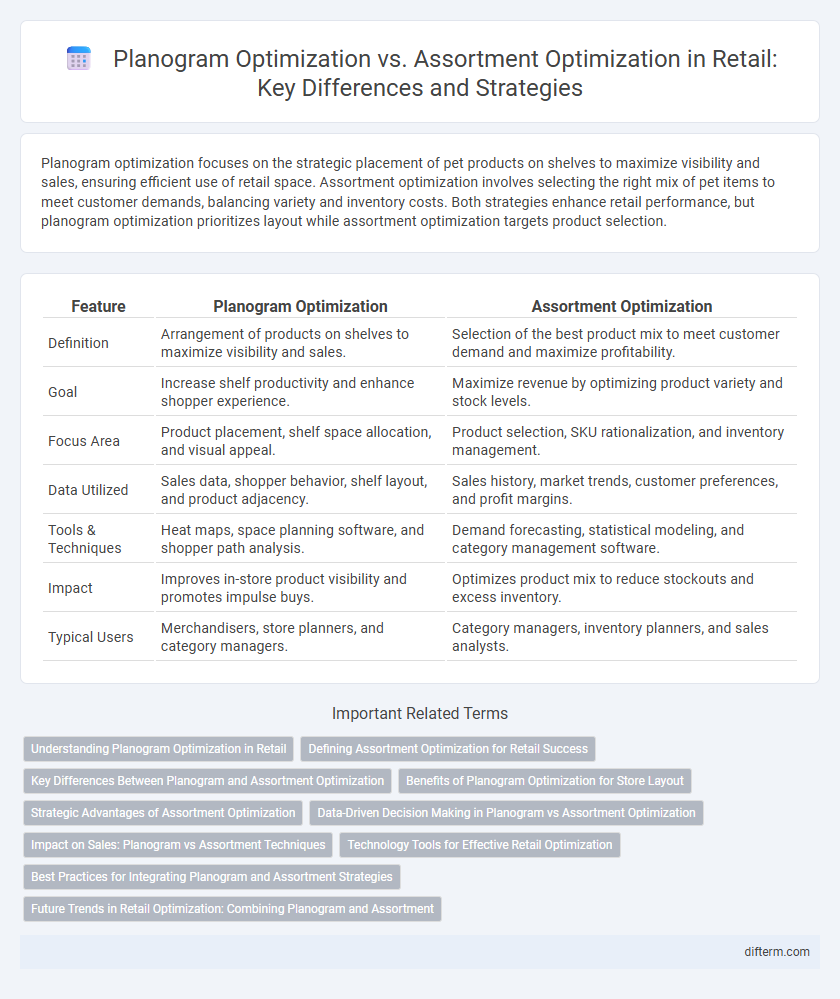Planogram optimization focuses on the strategic placement of pet products on shelves to maximize visibility and sales, ensuring efficient use of retail space. Assortment optimization involves selecting the right mix of pet items to meet customer demands, balancing variety and inventory costs. Both strategies enhance retail performance, but planogram optimization prioritizes layout while assortment optimization targets product selection.
Table of Comparison
| Feature | Planogram Optimization | Assortment Optimization |
|---|---|---|
| Definition | Arrangement of products on shelves to maximize visibility and sales. | Selection of the best product mix to meet customer demand and maximize profitability. |
| Goal | Increase shelf productivity and enhance shopper experience. | Maximize revenue by optimizing product variety and stock levels. |
| Focus Area | Product placement, shelf space allocation, and visual appeal. | Product selection, SKU rationalization, and inventory management. |
| Data Utilized | Sales data, shopper behavior, shelf layout, and product adjacency. | Sales history, market trends, customer preferences, and profit margins. |
| Tools & Techniques | Heat maps, space planning software, and shopper path analysis. | Demand forecasting, statistical modeling, and category management software. |
| Impact | Improves in-store product visibility and promotes impulse buys. | Optimizes product mix to reduce stockouts and excess inventory. |
| Typical Users | Merchandisers, store planners, and category managers. | Category managers, inventory planners, and sales analysts. |
Understanding Planogram Optimization in Retail
Planogram optimization in retail involves the strategic placement of products on shelves to maximize visibility and sales, leveraging data on consumer behavior and product performance. It focuses on the spatial arrangement within stores, ensuring high-demand items receive prominent positioning while minimizing wasted shelf space. This approach complements assortment optimization by enhancing in-store execution, driving higher conversion rates and improving overall retail efficiency.
Defining Assortment Optimization for Retail Success
Assortment optimization in retail involves strategically selecting and managing the range of products offered to maximize sales and meet consumer demand, using data analytics and customer insights for precise inventory decisions. Unlike planogram optimization, which arranges products for visual appeal and space efficiency on shelves, assortment optimization focuses on determining the ideal product mix to drive profitability and reduce stockouts. Leveraging advanced algorithms and market trends allows retailers to tailor assortments per store location, enhancing overall retail performance and customer satisfaction.
Key Differences Between Planogram and Assortment Optimization
Planogram optimization focuses on the visual arrangement of products on shelves to maximize space efficiency and enhance customer experience, while assortment optimization centers on selecting the right mix of products to meet consumer demand and increase sales. Planogram optimization emphasizes shelf layout, product placement, and inventory distribution, whereas assortment optimization prioritizes product variety, demand forecasting, and category performance. Both strategies use data analytics but target different aspects of retail merchandising to boost overall profitability.
Benefits of Planogram Optimization for Store Layout
Planogram optimization enhances store layout by strategically positioning products to maximize visibility and accessibility, which drives increased sales and improves customer experience. It leverages data on shopper behavior and product performance to ensure high-demand items receive prime shelf space, reducing stockouts and overstocks. Optimized planograms contribute to efficient space utilization, streamline restocking processes, and support consistent brand presentation across multiple locations.
Strategic Advantages of Assortment Optimization
Assortment optimization strategically enhances retail performance by aligning product selection with customer preferences and market demand, increasing sales potential and reducing inventory costs. It enables precise stocking decisions that maximize shelf space efficiency and improve customer satisfaction through tailored product offerings. Leveraging data-driven insights, assortment optimization supports dynamic merchandising strategies that adapt to seasonal trends and competitive pressures more effectively than basic planogram adjustments.
Data-Driven Decision Making in Planogram vs Assortment Optimization
Data-driven decision making in planogram optimization utilizes sales data, customer behavior, and spatial analytics to design shelf layouts that maximize product visibility and boost impulse purchases. In assortment optimization, advanced algorithms analyze market trends, historical sales, and consumer preferences to curate product mixes that enhance overall category performance and reduce inventory costs. Retailers leveraging these data-centric strategies achieve improved shelf efficiency and better alignment with consumer demand, driving higher revenue and customer satisfaction.
Impact on Sales: Planogram vs Assortment Techniques
Planogram optimization directly influences sales by strategically positioning products to maximize visibility and shopper convenience, often resulting in increased impulse purchases and higher basket sizes. Assortment optimization impacts sales by tailoring the product mix to meet local customer preferences, boosting overall relevance and reducing stockouts. Combining both techniques enhances revenue by aligning inventory assortment with effective visual presentation, driving customer satisfaction and loyalty.
Technology Tools for Effective Retail Optimization
Technology tools for planogram optimization leverage AI-driven analytics and shelf-space management software to enhance product placement, maximizing visibility and sales. Assortment optimization tools utilize big data and machine learning algorithms to analyze consumer preferences and sales trends, ensuring the right product mix for target markets. Integrating these solutions enables retailers to boost operational efficiency, reduce stockouts, and increase revenue through data-driven decision making.
Best Practices for Integrating Planogram and Assortment Strategies
Integrating planogram and assortment strategies enhances retail efficiency by aligning shelf space with product demand and consumer preferences, ensuring optimal inventory turnover. Employing data-driven insights such as sales metrics, customer demographics, and seasonal trends allows retailers to synchronize product placement with assortment decisions, maximizing sales potential and minimizing stockouts. Leveraging advanced analytics platforms enables continuous refinement of both planograms and assortment mix, driving improved accuracy in space allocation and targeted merchandising.
Future Trends in Retail Optimization: Combining Planogram and Assortment
Future trends in retail optimization emphasize integrating planogram optimization with assortment strategies to enhance inventory efficiency and shopper experience. Leveraging AI-driven analytics allows retailers to dynamically adjust shelf layouts and product selections based on real-time consumer behavior and demand patterns. This convergence increases sales velocity and reduces stockouts by aligning visual merchandising with targeted assortment planning.
planogram optimization vs assortment optimization Infographic

 difterm.com
difterm.com